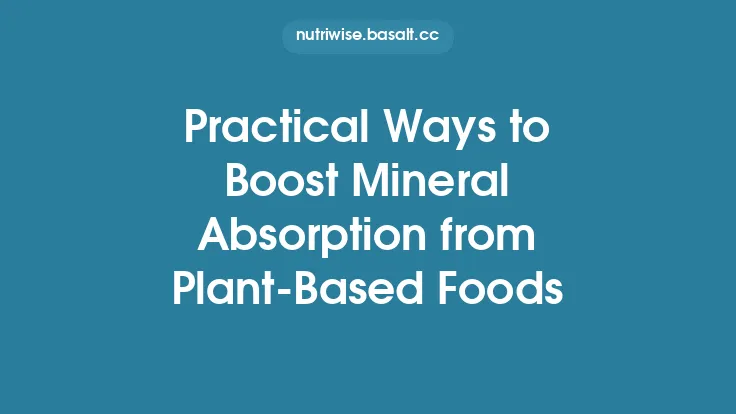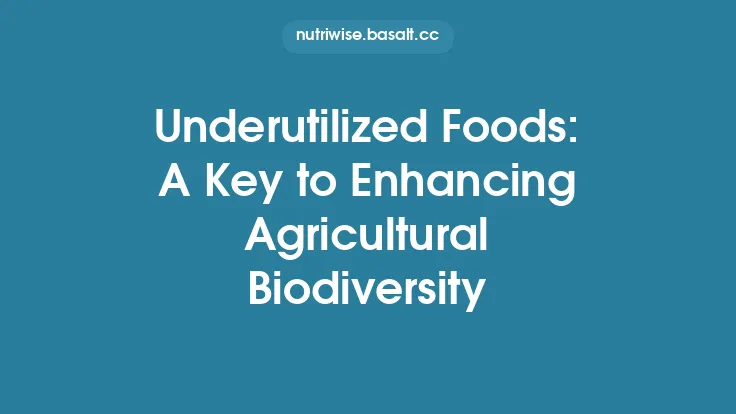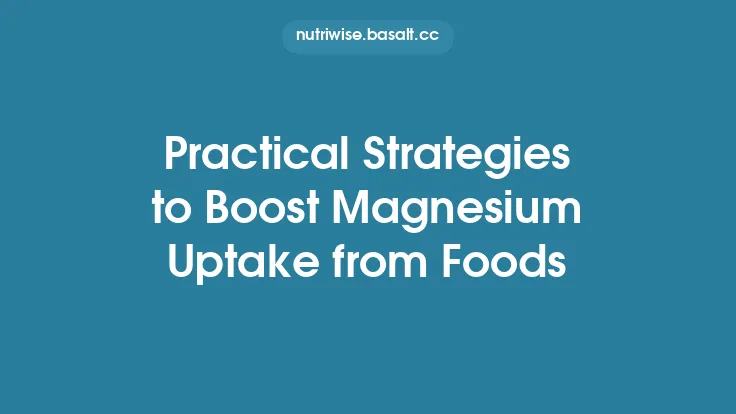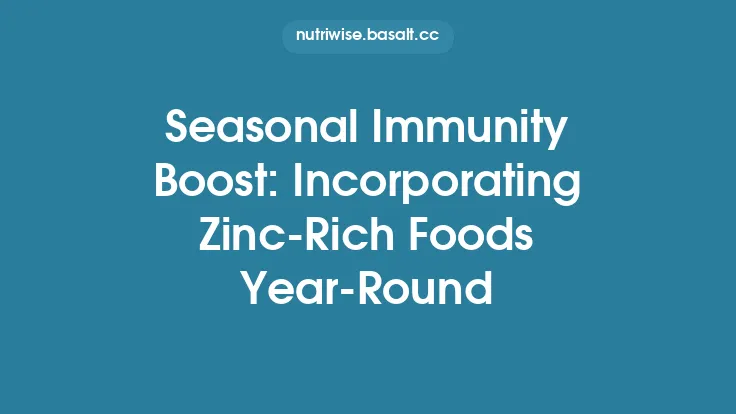Pollinators—bees, butterflies, moths, beetles, flies, and even some birds and bats—are the unsung architects of the world’s food supply. While they are celebrated for their role in wild ecosystems, their contribution to agriculture is equally vital: an estimated one‑third of the calories we consume each day depends on animal‑mediated pollination. Yet modern farming practices, habitat loss, pesticide exposure, and climate change have driven many pollinator populations into decline. One of the most effective, yet often overlooked, levers for reversing this trend lies on our plates: the foods we choose to grow, purchase, and eat. By deliberately supporting pollinator‑friendly foods, consumers can create a market signal that encourages growers to adopt practices and plant varieties that nurture pollinator health, thereby amplifying biodiversity across agricultural landscapes.
Why Pollinators Are Central to Biodiversity
Ecological Services Beyond Yield
Pollinators facilitate gene flow among plant populations, which maintains genetic diversity and resilience to pests, diseases, and climatic fluctuations. Diverse plant genetics, in turn, support a wider array of herbivores, predators, and decomposers, creating a cascade of biodiversity benefits that extend far beyond the fields themselves.
Keystone Interactions
Many wild plants rely exclusively on specific pollinator taxa. When those pollinators disappear, the plants fail to reproduce, leading to local extinctions that ripple through food webs. By safeguarding pollinator populations, we protect these keystone interactions and the myriad species that depend on them.
Economic Valuation
Global estimates place the monetary value of pollination services at $235–$577 billion annually. This figure underscores that pollinator health is not a peripheral environmental concern but a core component of food security and economic stability.
Identifying Pollinator‑Friendly Foods
Not all crops are equally beneficial to pollinators. Some provide abundant nectar and pollen, while others offer limited resources or even pose risks due to pesticide residues. Below is a taxonomy of foods that are consistently recognized as pollinator‑friendly:
| Crop Category | Representative Species | Nectar/Pollen Traits | Seasonal Bloom Window |
|---|---|---|---|
| Fruit Trees | Apple (*Malus domestica), Cherry (Prunus avium), Plum (Prunus domestica*) | High‑volume, sugar‑rich nectar; abundant pollen | Early‑spring to early‑summer |
| Berry Shrubs | Blueberry (*Vaccinium corymbosum), Raspberry (Rubus idaeus), Blackberry (Rubus fruticosus*) | Moderate nectar, pollen rich in protein | Mid‑summer |
| Oilseed Crops | Sunflower (*Helianthus annuus), Canola (Brassica napus*) | Large composite heads offering both nectar and pollen | Late‑summer |
| Legumes | Alfalfa (*Medicago sativa), Lentil (Lens culinaris), Chickpea (Cicer arietinum*) | Pollen‑dense, nectar moderate | Spring to early‑summer |
| Herbs & Spices | Basil (*Ocimum basilicum), Dill (Anethum graveolens), Coriander (Coriandrum sativum*) | Small flowers, high nectar concentration | Throughout growing season |
| Vegetables with Open Flowers | Squash (*Cucurbita spp.*), Cucumbers (*Cucumis sativus), Eggplant (Solanum melongena*) | Accessible pollen for large bees; nectar varies | Summer |
| Nectar‑Rich Flowers for Forage | Lavender (*Lavandula angustifolia), Borage (Borago officinalis), Marigold (Tagetes spp.*) | Extremely high nectar output; often intercropped | Variable |
Key Selection Criteria
- Floral Morphology – Open, shallow corollas accommodate a broader suite of pollinators, whereas deep tubular flowers may restrict access to specialist bees.
- Bloom Phenology – A staggered sequence of flowering times ensures continuous forage throughout the growing season.
- Pesticide Residue Profile – Crops cultivated with integrated pest management (IPM) or organic inputs reduce toxic exposure for pollinators.
- Nutrient Composition – Pollen rich in protein, lipids, and essential amino acids is especially valuable for larval development.
Agronomic Practices That Enhance Pollinator Habitat
Even the most pollinator‑friendly crops can become ecological dead‑ends if grown under intensive, monocultural regimes. The following practices transform agricultural fields into functional pollinator habitats:
1. Diversified Crop Rotations and Intercropping
- Temporal Diversity: Rotating legumes with oilseeds and fruit trees creates alternating bloom periods.
- Spatial Diversity: Intercropping sunflowers with beans or planting hedgerows of flowering herbs along field margins supplies continuous forage.
2. Reduced or Targeted Pesticide Use
- Threshold‑Based Applications: Apply insecticides only when pest populations exceed economic injury levels.
- Selective Products: Favor compounds with low toxicity to bees (e.g., spinosad, neem oil) and avoid systemic neonicotinoids.
- Application Timing: Spray in the late evening or early morning when pollinators are less active.
3. Preservation and Creation of Semi‑Natural Habitats
- Field Margins: Maintain strips of native wildflowers, grasses, and shrubs at least 3–5 m wide.
- Bee Hotels and Nesting Substrates: Install wooden blocks, hollow stems, or ground‑level sand patches to support solitary bees.
- Water Sources: Provide shallow, pesticide‑free water dishes with landing platforms.
4. Soil Health Management
- Organic Matter Enrichment: Compost and cover crops improve soil structure, fostering a robust microbial community that indirectly benefits pollinator nutrition through healthier plant growth.
- Reduced Tillage: Minimizes disturbance of ground‑nesting bee habitats.
5. Genetic Selection for Floral Traits
- Extended Bloom Varieties: Breeding programs that select for longer flowering periods or increased nectar volume can amplify pollinator benefits without sacrificing yield.
- Disease‑Resistant Lines: Reducing the need for chemical controls further protects pollinator health.
Integrating Pollinator‑Friendly Foods Into Consumer Diets
Consumers wield purchasing power that can reshape production patterns. The following strategies make pollinator‑friendly foods a regular part of everyday meals:
A. Seasonal and Local Sourcing
- Farmers’ Markets: Directly support growers who practice pollinator‑positive agriculture.
- Community‑Supported Agriculture (CSA): Membership often includes a rotating basket of fruit, berries, and vegetables that align with pollinator bloom cycles.
B. Label Awareness
- Pollinator‑Friendly Certification: Look for logos indicating adherence to pollinator‑conserving standards (e.g., “Bee Friendly” or “Pollinator Habitat Certified”).
- Organic and IPM Labels: While not a guarantee, these certifications typically involve reduced pesticide use.
C. Culinary Diversity
- Incorporate Under‑utilized Pollinator Crops: Add sunflower seeds, lavender-infused dishes, or borage leaves to recipes.
- Home Gardening: Even a modest balcony garden with herbs, dwarf fruit trees, and flowering vegetables can provide personal pollinator forage and fresh produce.
D. Food Service and Institutional Procurement
- Menu Planning: Restaurants and cafeterias can feature pollinator‑friendly items as seasonal specials, creating demand.
- Bulk Purchasing Agreements: Institutions can negotiate contracts that prioritize farms employing pollinator‑supportive practices.
Policy Levers and Market Incentives
Scaling pollinator‑friendly food production requires alignment of public policy, private investment, and consumer demand.
- Subsidies for Habitat Creation – Direct payments to farmers for establishing flower strips, hedgerows, or nesting sites.
- Pollinator Impact Assessments – Mandating that large‑scale agricultural projects evaluate and mitigate effects on pollinator populations.
- Research Grants – Funding for breeding programs focused on nectar‑rich, disease‑resistant varieties.
- Tax Credits for Certified Producers – Reducing tax burdens for farms that meet pollinator‑friendly certification criteria.
- Public Procurement Standards – Government agencies can require a percentage of purchased produce to come from pollinator‑supportive sources.
These mechanisms not only protect pollinators but also generate co‑benefits such as improved soil health, reduced pesticide costs, and enhanced resilience to climate variability.
Measuring Impact: From Field to Fork
Robust monitoring is essential to verify that pollinator‑friendly foods are delivering biodiversity gains.
- Pollinator Surveys: Standardized transect counts and pan‑trap sampling assess species richness and abundance on farms.
- Floral Resource Mapping: GIS tools track the spatial distribution and phenology of pollinator‑providing crops.
- Yield and Quality Metrics: Comparing pollinator‑rich fields with conventional ones quantifies economic benefits (e.g., fruit set, seed weight).
- Life‑Cycle Assessment (LCA): Incorporating pollinator health into LCA models provides a more holistic environmental footprint for food products.
- Consumer Behavior Analytics: Tracking sales of certified pollinator‑friendly items gauges market response and informs outreach strategies.
Data from these sources can be aggregated into dashboards for growers, policymakers, and consumers, fostering transparency and continuous improvement.
Future Directions and Emerging Opportunities
- Digital Pollinator Platforms: Mobile apps that connect growers with pollinator experts, provide real‑time pest thresholds, and certify habitat enhancements.
- Synthetic Nectar Technologies: Research into biodegradable, nutrient‑rich nectar mimics could supplement natural forage during dearth periods without harming pollinators.
- Urban Agriculture Integration: Rooftop farms and vertical gardens can be designed with pollinator corridors, extending benefits into densely populated areas.
- Climate‑Adaptive Varieties: Breeding for heat‑tolerant, drought‑resistant pollinator‑friendly crops ensures resilience under shifting climate regimes.
By staying at the intersection of agronomy, ecology, and consumer culture, the movement toward pollinator‑friendly foods can evolve from a niche initiative into a cornerstone of sustainable food systems.
In summary, supporting pollinator‑friendly foods is a concrete, actionable pathway to bolster biodiversity. Through informed crop selection, pollinator‑centric farming practices, mindful consumer choices, and supportive policy frameworks, we can create a virtuous cycle where healthier pollinator populations enhance ecosystem function, agricultural productivity, and ultimately, the nutritional quality of the foods on our tables. The ripple effects extend far beyond the fields—preserving the intricate web of life that underpins a resilient planet.





